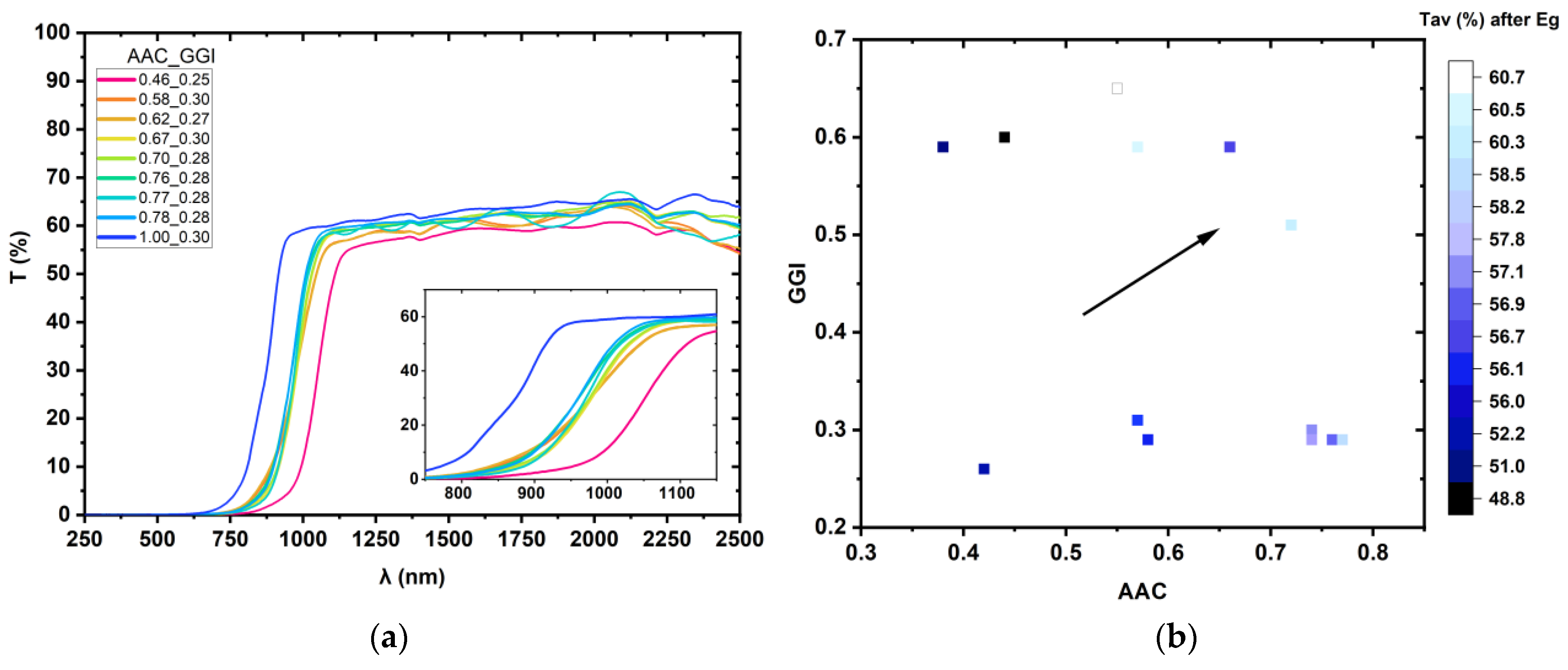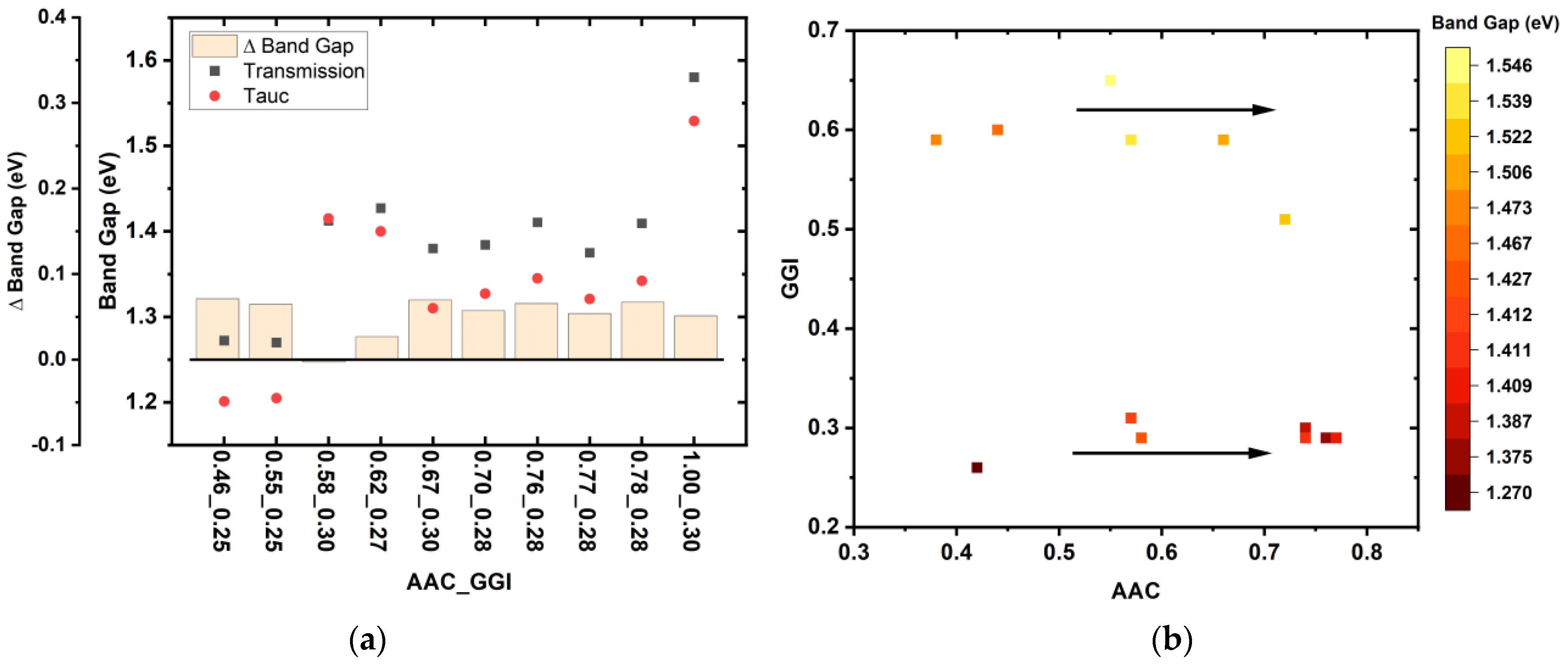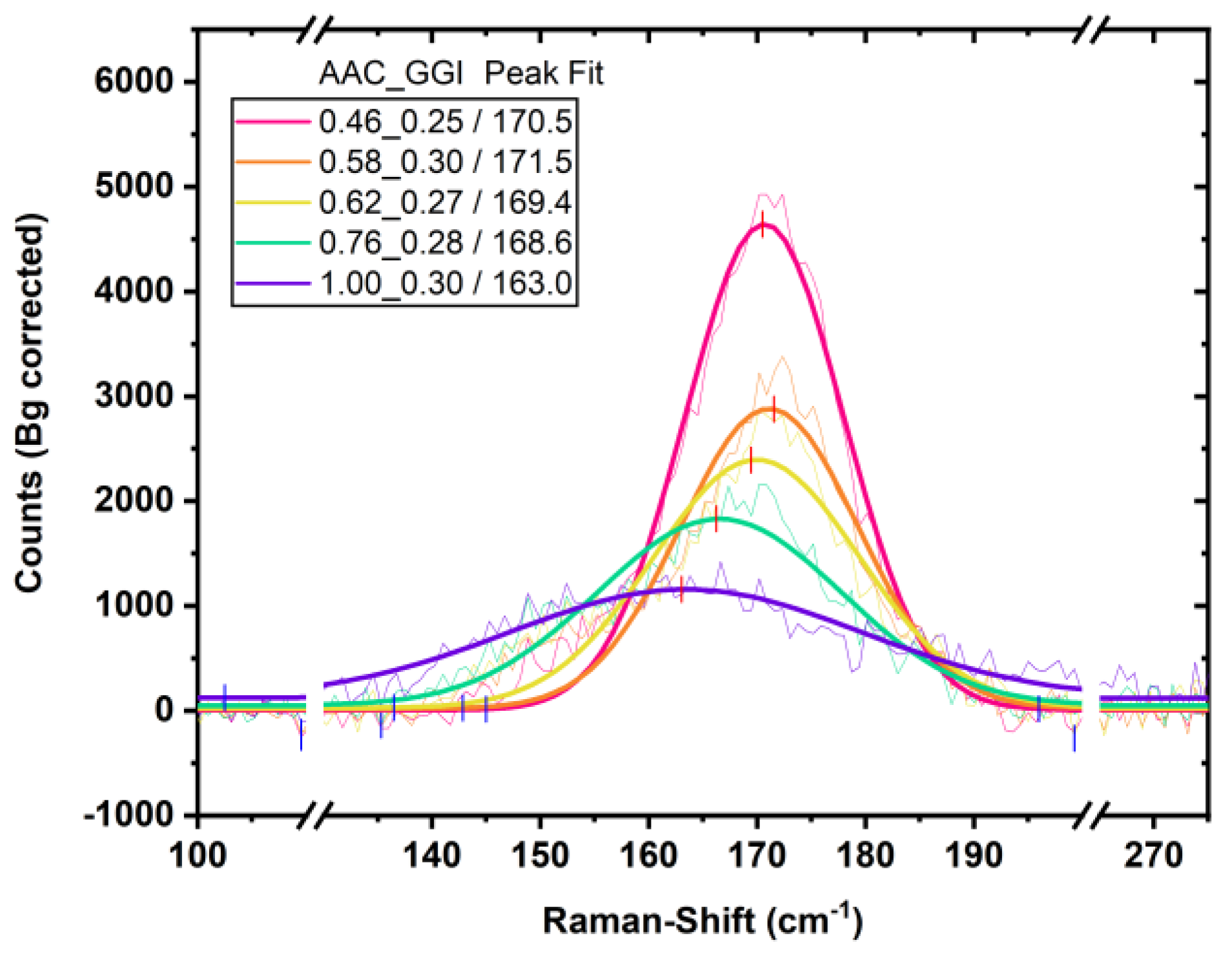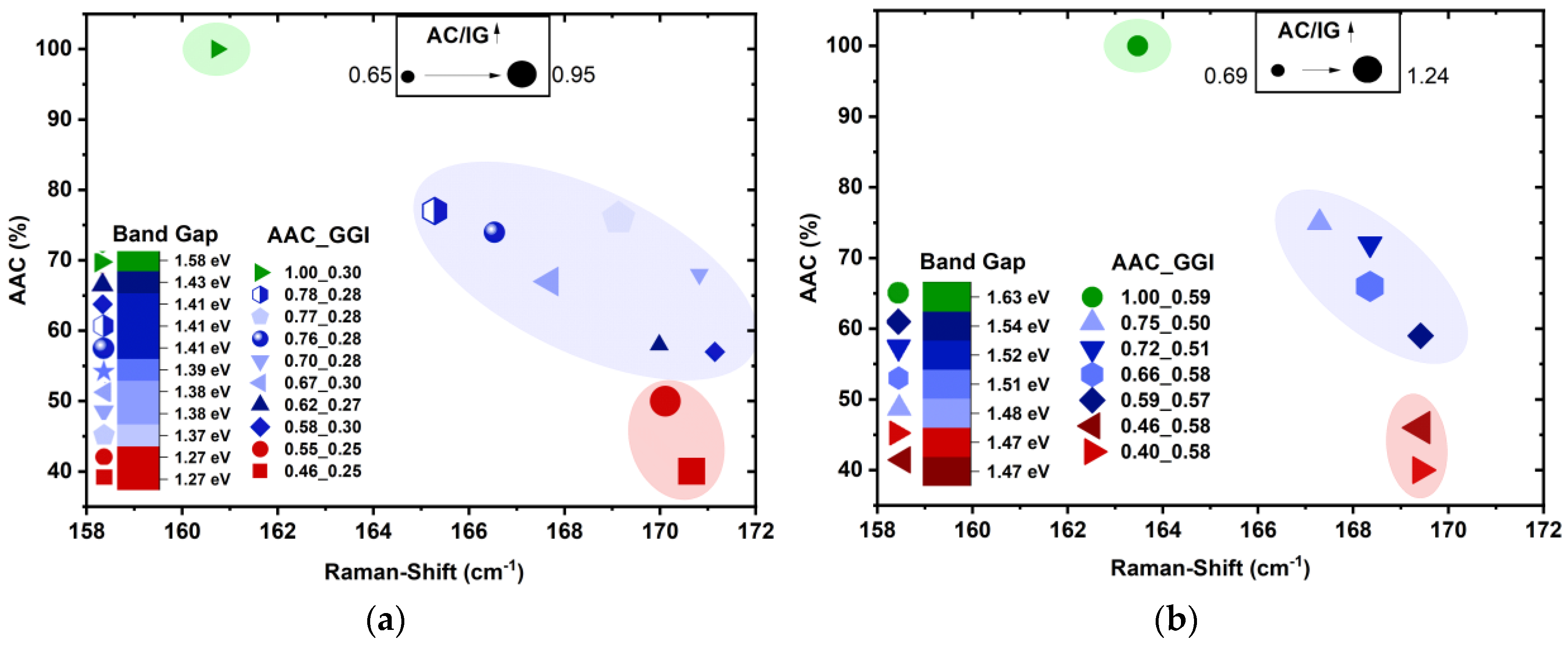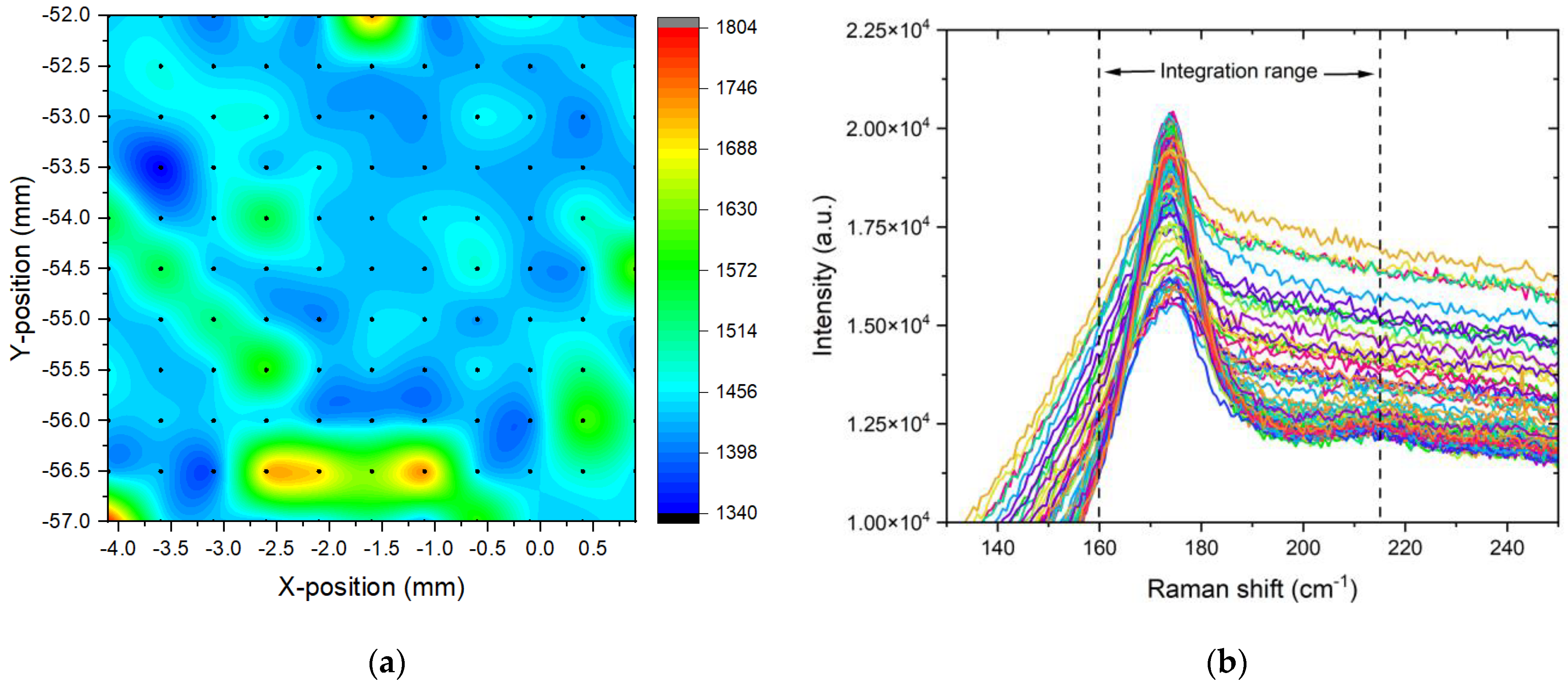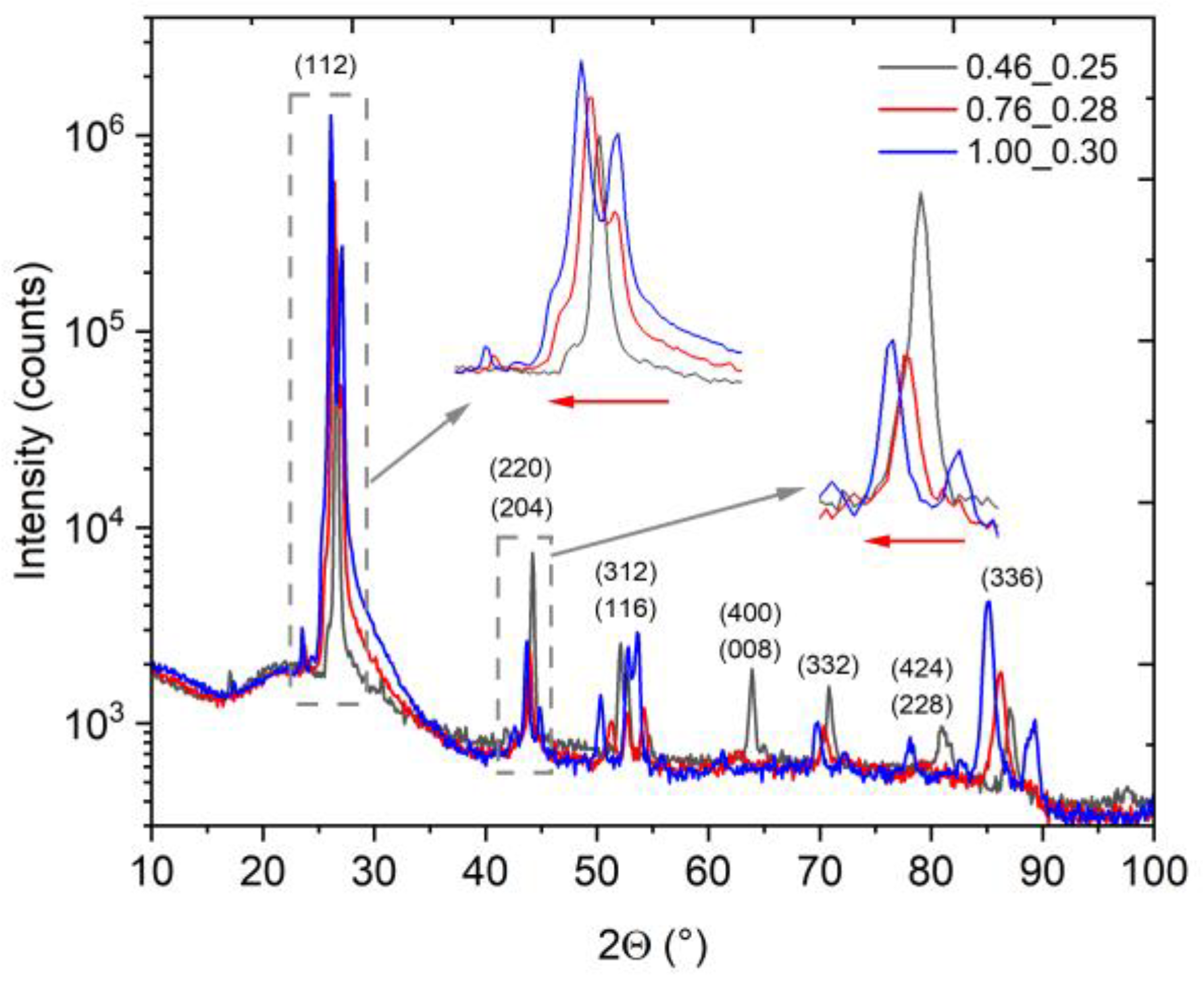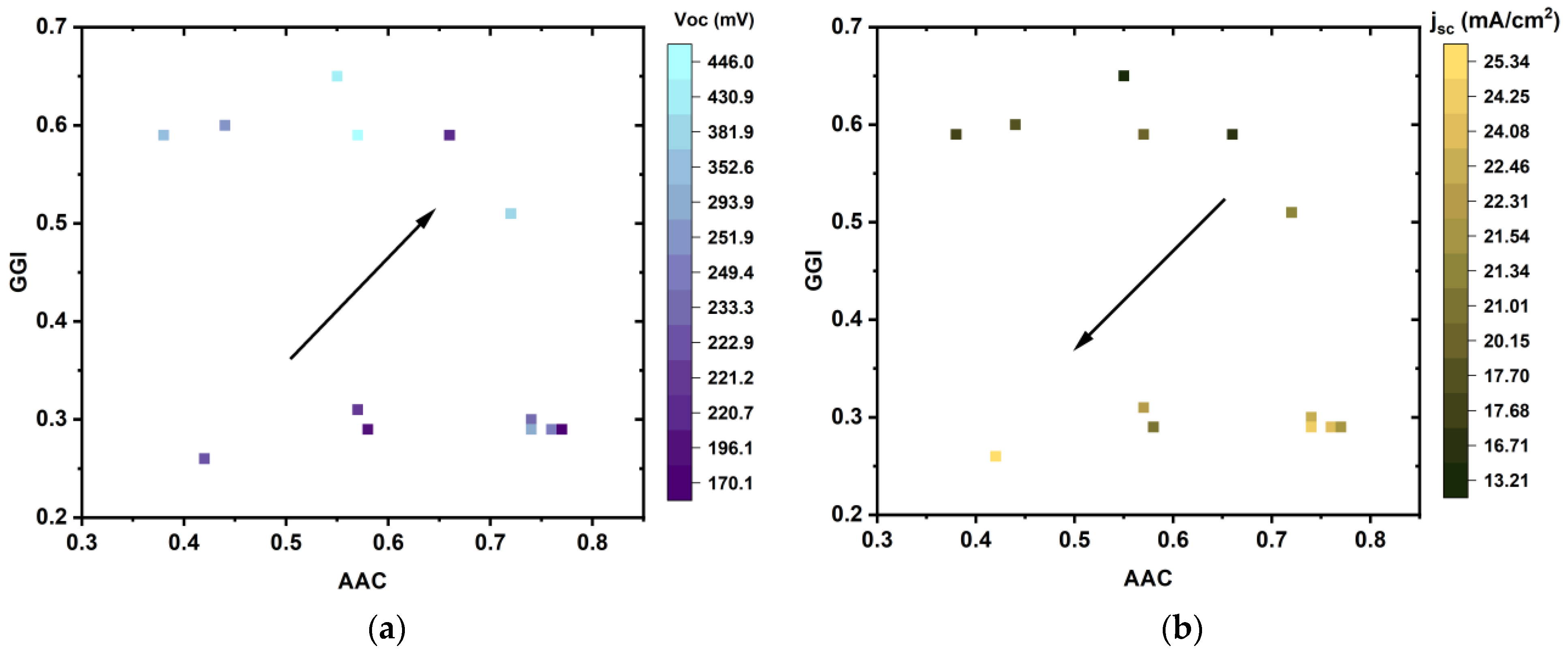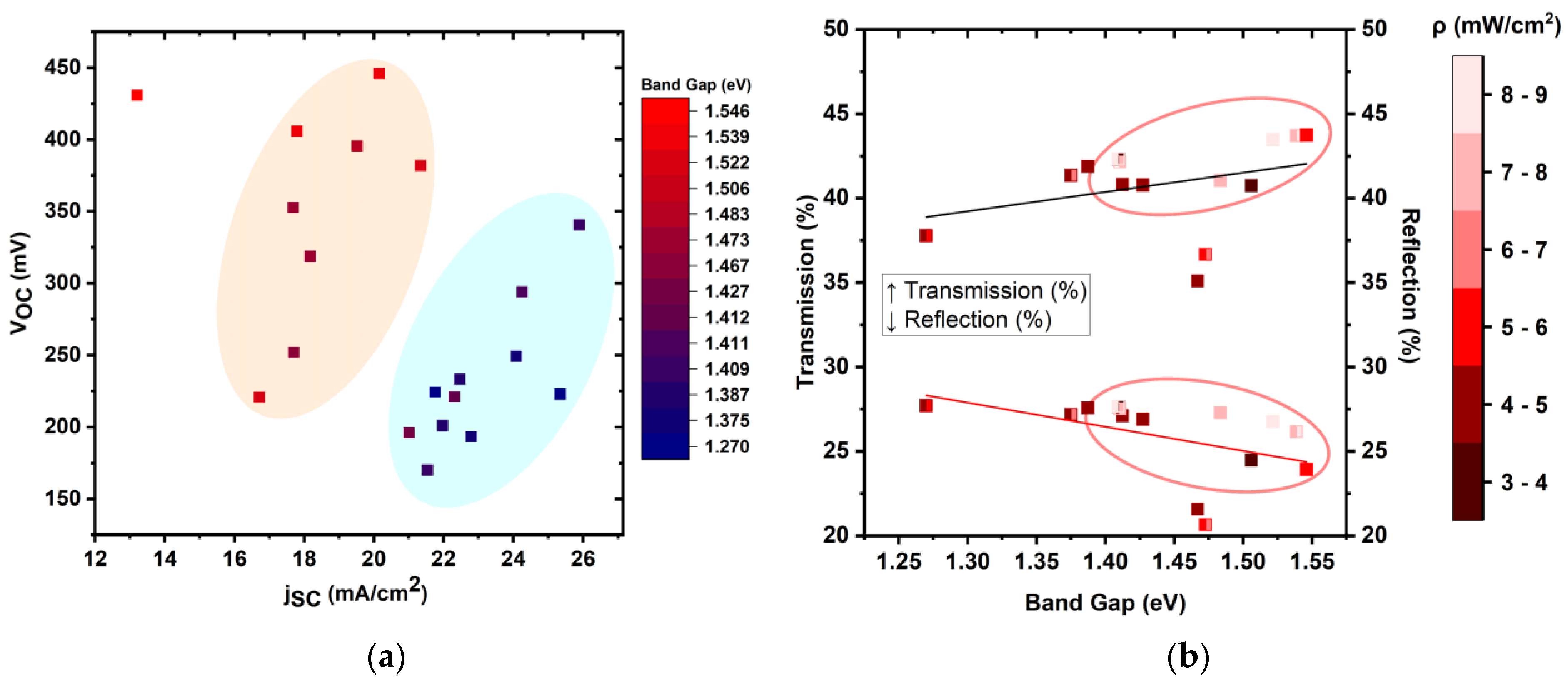3.1. Transmission/Reflection
Transmission measurements of the sample series with low Ga content (GGI ratio between 0.25 and 0.30) and AAC varying between 0.46 and 1.00 are shown in
Figure 1a. The corresponding data for the series with high Ga content (GGI ratio between 0.50 and 0.59) and AAC between 0.40 and 1.00 is given in the
Supplementary Materials Figure S1a. Different groups of compositions can be identified with a similar wavelength where the steep transmission rise occurs (see also the inset). The largest gap wavelength is found for GGI = 0.25 and AAC = 0.46, and the lowest one for GGI = 0.30 and AAC = 1.00, indicating a clear rise in band gap with increasing Ga and Ag content, as will be detailed below. Interestingly, all the other compositions in-between group around a similar gap wavelength, resulting from the highly comparable Ga content and a variation of AAC from 0.58 to 0.78 only. The transmission rise shortly below the gap wavelength is comparably small for all cases, indicating a promisingly low number of states reaching into the band gap. Above the band gap wavelength, the transmission curves stay at a relatively constant level. Furthermore, it can be observed that in some cases clear Fabry-Perot interferences occur, whereas for other samples basically a flat profile is identified. The mostly flat profiles can be related to a high surface roughness of the samples which is also indicated by SEM topographical views and a high diffuse reflection (not shown here).
The average sub-gap transmission
Tav was calculated by integration of the transmission from the wavelength of half maximum at the steep transmission rise to the long wavelength end (and accordingly later for reflection). After division by the number of wavelengths included in the integral, an average was obtained, as shown in
Figure 1b. The values ranged between approx. 50 and 60%, still leaving room for improvement when thinking about application in, e.g.
, tandem solar cells. However, it has to be considered that these transmission values were taken for absorbers on glass substrates with a high refractive index contrast of 1 (air) to approx. 2.5 (absorber), resulting in a theoretical reflection of, on average, 25% and an experimentally measured one of approx. 30% (see
Figure S1b). The high experimental values can also be correlated with the extremely high diffuse contribution of roughly two-thirds of the reflection values. In the device, including the window layers of CdS, i-ZnO and Al:ZnO, and perhaps even an antireflection coating, these numbers will be significantly reduced. The trend to be noted from
Figure 1b is an increase in average sub-gap transmission with increasing Ag content and generally a further benefit of higher Ga ratios (compare the indicative arrow in the figure).
The optical data were utilized for band gap extraction of the various absorbers. Therefore, in the first and preferred case, the transmission curves were linearly fitted in the range of steepest slope and the wavelength values read out for 0%
T. Subsequent conversion to the energy delivered the band gap values. An alternative, and the second approach of band gap extraction from transmission and reflection data, is via a Tauc plot of (
αh
ν)² vs. (h
ν), where
α represents the absorption coefficient and (h
ν) stands for the photon energy. The following equation is used to determine the absorption coefficient [
15]
where
d is the film thickness, and
R and
T are the recorded reflectance and transmittance, respectively.
The resulting band gap values and their differences are plotted together in
Figure 2a. The two approaches deliver comparable results with approx. 0.05
–0.07 eV higher values for the direct extraction from transmission values. As a constant offset is observed, we favor the first approach of direct slope fitting due to the ease of access and independence of additional parameters (in particular, film thickness). Compared to literature values [
10], our band gap numbers are on average 0.1 eV higher for similar compositions, which may be explained by the usage of Tauc plots in the literature references.
An overview of band gap values for our samples is given in
Figure 2b as a function of AAC and GGI ratio. Band gap values between 1.27 and 1.55 are found within our composition ranges of AAC between 0.36 and 1.00 and GGI between 0.25 and 0.59. Clear trends of increasing band gap with increasing Ag and increasing Ga content are confirmed as the arrows indicate.
3.2. Raman Spectroscopy
The most common Raman peak of CIGSe is the A
1 mode correlated to the vibration of the Se atoms. The A
1 mode means that the Se anions are vibrating in the a-b plane and the cations remain fixed [
16]. The location of the CIGSe A
1 Raman mode is between 173 cm
−1 (CISe) and 183 cm
−1 (CGSe) [
17]. Another peak around 220 cm
−1 or above may be correlated to mixed B
2/E vibrational modes [
18]. Hereby, the B
2 mode appears more prominent and relates to the vibration of the cations against the anions in the c-direction [
16]. Furthermore, subtle peaks can appear at 150 cm
−1, indicating ODCs (ordered defect compounds), or at 260 cm
−1, representing the A
1 mode of Cu
2-xSe [
18]. Whereas ODCs are typical for Cu-poor samples, copper selenides occur with Cu-rich compositions.
The investigation of ACIGSe with Raman spectroscopy is less well understood. The Raman peak of ACIGSe is expected to be found between 176 cm
−1 and 184 cm
−1 depending on the Ag content (and in the reference, GGI = 0.85) [
7]. Generally, it can be noted that the A
1 Raman peak shifts to the left (smaller wavenumbers) for larger and to the right (larger wavenumbers) for smaller cations. As Ag has a larger atomic radius than Cu (160 pm as opposed to 135 pm [
19]), but In is larger than Ga (155 pm as opposed to 130 pm [
19]), the peak shifts to the left with increasing Ag but to the right with increasing Ga content. The higher radii are correlated to larger masses as well as to increased lattice constants, both contributing to smaller Raman shifts [
11]. Furthermore, an increasing Cu content (as long as below the stoichiometric ratio of CGI = 1) was correlated to a left shift of the A
1 mode, [
18] leading to the same expectation for Ag + Cu (AC/IG ratio).
Figure 3 shows the background-corrected and baseline-subtracted main Raman signal of ACIGSe with various Ag contents and GGI around 0.3. The peak values determined by Gaussian fitting are also indicated in the legend. The general trend of decreasing Raman shift with increasing Ag content is clearly confirmed. Here the values lie between 163 cm
−1 and 171 cm
−1 as we are looking at low GGI ratios of 0.25
–0.30. At the left side of the main A
1 peak, a small shoulder is observed which could be correlated to the existence of an ODC [
11]. Corresponding to the left shift of the Raman peak with increasing Ag content, the intensity also decreases. This observation can again be correlated to the larger atomic size of Ag compared to Cu and a resulting distortion in the crystal lattice, which is reflected in a less pronounced Raman signal. The decrease in intensity is also in line with a generally observed larger FWHM (full width at half maximum) of the Raman peaks with increasing AAC (not shown here).
For
Figure 3, representative samples were chosen to show the main Raman peak and composition-related trends. The overview of the Raman A
1 peak positions for all samples is given in
Figure 4. In part (a) the values for low GGI ratios (0.25
–0.30) are presented in dependence of AAC and color-coded by band gap. Accordingly,
Figure 4b shows the relations for high GGI ratios (0.50
–0.59). The ratio of AC/IG is also considered in the plots and represented by varying sizes of the symbols. Generally, the trend of decreasing Raman shift with increasing AAC can be confirmed. Furthermore, three groups of band gaps can be separated along with AAC content: 1.27 eV, [1.37,1.43] eV, and 1.58 eV for low GGI and 1.47 eV, [1.48,1.54] eV and 1.63 eV for high GGI. Between the groups, a partial overlap of the Raman peak position occurs. The origin may be found in the difference in AC/IG. Consequently, samples from the red group with AC/IG up to 0.95 or 1.24 (
Figure 4a and b, respectively) show similar Raman shifts as samples from the blue group with higher AAC but smaller AC/IG. Also, within the groups of highly similar Ga ratios and hence band gaps, the trend of decreasing Raman shift comes mostly along with increasing AC/IG ratio, which is in agreement with the expectation in the literature. In addition, around the single point of the green group an elliptical area is indicated, giving an idea of variations occurring even for similar compositions and band gaps.
Aside from the expected variation of the Raman signal for different compositions, another variation of the Raman signal across one sample is observed (see
Figure 5a). The shown map spans an area of 5 mm x 5 mm with a Raman spectrum recorded every 0.5 mm. The Raman raw signal integrated around the A
1 peak in the range of 160–215 cm
−1 is mapped. All the corresponding single spectra are shown together in
Figure 5b. They reveal changes in intensity and differences in the sharpness of the peaks. At the one end, high-intensity spectra with a broad A
1 peak are observed. At the other end, high intensities appear at the A
1 peak only, which is characterized by a small FWHM. Additionally, in these cases, a peak shortly below 220 cm
−1 is clearly recognized, which can be attributed to the B
2 mode. For further illustration,
Figure S2 plots the Raman spectra at the maximum and minimum values of
Figure 5a only. In the end, the broad high-intensity spectra result in large integrated values (shown in orange and reddish in
Figure 5a), whereas the spectra with sharp peaks and small FWHM deliver small integration numbers (bluish in
Figure 5a). Therefore, the blue spaces in
Figure 5a may be correlated to areas with better crystallinity, and the reddish areas mark lower material quality.
3.3. X-ray Diffraction
Exemplary XRD spectra of ACIGSe absorbers with varying Ag content (AAC = 0.46, 0.76, and 1.00) and Ga content in a comparably low range (GGI = 0.25, 0.28, and 0.30) are visualized in
Figure 6.
The main ACIGSe peak attributed to the (112) orientation is observed around 26–27° and shows a shift to smaller angles with increasing Ag content. In detail, it occurs at 26.6° for the composition of AAC = 0.46 and GGI = 0.25 and shifts to 26.35° for AAC = 0.76 and GGI = 0.28 and to 26.1° for AAC = 1.00 and GGI = 0.30. The left shift of the main peak with increasing Ag content may be related to the larger size of the Ag compared to the Cu atom (see also Raman section) and a related larger lattice constant [
20]. According to the Bragg formula, a larger lattice constant results in smaller scattering angles. Furthermore, for larger Ag concentrations (here AAC ≥ 0.76) a secondary peak appears at slightly higher angles than the (112) peak and experiences a shift to larger angles for increasing Ag concentration. This occurrence of a satellite peak was also observed in the literature, but could not be attributed to a certain phase and remained linked to ODCs and related secondary phases only [
21].
The peaks at ~42–45°and ~52–54° are attributed to the (220)/(204) and the (312)/(116) orientation, respectively. Like the (112) peak, they reveal a left shift with increasing Ag content as well as the occurrence of a side peak towards the longer angles for higher AAC. The separation of these doublet peaks may be attributed to a distortion of the tetragonal unit cell which apparently becomes more prominent with increasing Ag content [
20]. Further peaks at ~64°, ~70–72°, ~78–81°, and ~85–89° may be linked to the ACIGSe (400)/(008), (332), (424)/(228), and (336) orientations. Also, secondary phases become likely to be seen in the more compositionally complex systems.
The increase in the intensity of the main (112) peak along with the decreasing signal of the (220)/(204) doublet for growing Ag content hints at an improved crystal quality with increasing Ag incorporation. The splitting of the peaks, in contrast, remains an indication of lattice distortion compared to the less complex systems. All in all, our XRD spectra are in agreement with literature data as well as with the trends we derived from the optical measurements.
3.4. Current-Voltage Measurements
For each composition, one substrate was processed to solar cells and characterized by
jV measurements. The resulting open circuit voltage
Voc, short circuit current density
jsc, and power density
ρ values were averaged over all cells, i.e., eight in the ideal case, and accordingly reduced for those with a fill factor below 25%.
Voc and
jsc as a function of GGI and AAC ratios are presented in
Figure 7a,b, respectively. The expected trends of increasing
Voc and decreasing
jsc with increasing Ag and Ga content can be followed.
Voc and
jsc are correlated with GGI and AAC via the band gap, for the latter see
Figure 2b. In the
jsc/
Voc landscape depicted in
Figure 8a, two groups become visible: samples with band gaps between 1.27 and 1.43 eV and those with
Eg between 1.47 and 1.55 eV. The larger band gaps are related to higher
Voc and lower
jsc, and the smaller ones to lower
Voc and higher
jsc. The direct correlation is that larger band gaps imply higher energetic photons to be absorbed more efficiently, resulting in a higher
Voc, yet overall fewer photons being absorbed, i.e., lower
jsc.
Figure 8b shows the power densities achieved in correlation with the transmission and reflection values for the different samples. As was already seen in
Figure 1b, larger AAC ratios are correlated with higher sub-gap transparency, which was found to be associated with lowered reflection, in particular for low GGI (see also
Figure S1b). As higher AAC ratios are equally linked to a larger band gap, the trend of increasing transmission and reducing reflection with higher band gaps, apparent in
Figure 8b, becomes clear. Along with this beneficial improvement in transmission, the achieved power density also rises, proving a clear benefit of the large band gap absorbers for future applications.
